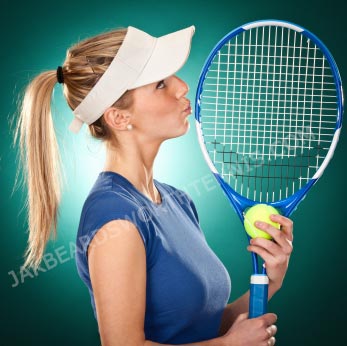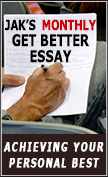MARCH / APRIL, 2013:
SELF-TALK: Good, Bad or Indifferent
Everyone does it in one form or another, at every level of the game, particularly in a heated, closely contested match that's up for grabs. You've seen it. You've heard it. You've mostly likely done it.
 Certainly there have been a few stoic ones at the top of the game that you never heard a peep out of, nor, for that matter, seldom displayed any accompanying facial or body language, positive or negative. Bjorn Borg immediately comes to mind. Chris Evert and Arthur Ashe were other notable examples from an earlier time.
Certainly there have been a few stoic ones at the top of the game that you never heard a peep out of, nor, for that matter, seldom displayed any accompanying facial or body language, positive or negative. Bjorn Borg immediately comes to mind. Chris Evert and Arthur Ashe were other notable examples from an earlier time.
Today's closest representative would have to be Roger Federer, who seldom reveals anything to his opponents and, almost without exception, just goes about his business.
Negative self-talk is seldom, if ever, productive. Only John McEnroe, in his heyday, could go on a complete out-of-control rant, at himself, and then somehow get right back to playing brilliantly on the very next point. Turning a high negative into a high positive is tricky stuff. Nonetheless, in his book, You Cannot Be Serious, he indicates he would have been far better off without all the McBrat outbursts.
Do not fall victim to that on your court. It's tempting. In the spirit of something I recently said, in a different context, to one of my players who was insisting on playing right on top of the baseline like Andre Agassi used to; "You're no Agassi," lose any histrionics and gain control of your emotions since you're no McEnroe either.
Interestingly, what's the biggest difference in Andy Murray's game since Ivan Lendl, the sour, dour Czech legend began coaching him about a year ago? Not the ball striking to any noticeable degree. Yes, his physical fitness is right there at the top, but that's not the defining component either. It's Murray ditching all the gut wrenching drama for all to see with all the emotionally exhausting, roller coasting baggage. It's the above the neck fitness that's made the difference.
The judge and jury in you always gets in the way of the player within. Tim Galwey, in his groundbreaking book The Inner Game, way back in 1974, was the first to really articulate our conflicting on-court personas with his "Self-One" and "Self-Two" depiction. One being the free flowing player just doing it, completely unencumbered mentally and emotionally, trusting and accepting the game they arrived with despite any flaws. The other being the unforgiving, judgmental, unrealistic goal setting, vitriol-spewing, bad twin who's never satisfied with himself and thus, can never really succeed.
These individuals tend to carry-on audible, running conversations with themselves, sometimes expletive loaded, after seemingly every point lost, whether on an error or even in response to an opponent's winner. One could call it a bad temper. Too simple. Another could say it's a deflection of embarrassment over the shots they're missing, implying to all in view, including the opponent(s), that they never miss those shots.
I'm embarrassed when I witness these players conversing with themselves in the 3rd person: "Oh c'mon Kenny, you never miss this many shots," as if it's the first time it has ever happened.
Jimmy Connors, well known for his uncanny ability to incite positive support from a crowd, never talked negatively to himself, only the officials. He did engage in chatter with his fans in response to their cheers and urging such as, "I'm trying as hard as I can." Or, "This is what they want; this is what they come for," while yelling into a courtside microphone. Best of all: "He's going to have to pass me 62 times," referencing his attacking the net style of play in one of his memorable U.S. Open triumphs against an opponent 15 plus years his junior.
"Shut-up and compete," isn't that what the noted corporate consultant Tom Peters used to dispense for boatloads of money when preaching his gospel to middle-managers at the IBMs of the world?
Positive self-talk is another matter entirely. You see, and quietly hear – even lip read – some of the best pro tour players having motivating, solution-oriented conversations with themselves to stay on task no matter what the adversity they're facing. Some are completely silent, even lip reading produces nothing, but their body and facial language reveal that they're never going away.
As much as I do not like listening to Maria Sharapova, I really like watching her. Not so much in the point, but between points when she, without fail, positions herself about halfway between the baseline and the court's end, back to the net, staring into and fiddling with her strings, huddling positively with herself for a few seconds prior to turning and walking purposely, all business, expressionless steely-eyed, back to the baseline to serve or return the next point. Never a deviation in her re-booting.
Soren Kierkegaard cannot be known for his tennis prowess since he left this Earth in 1855, but he is still highly regarded today as a philosopher of exceptional note whose take on the human condition was all encompassing, and very much applicable today in tennis' real life microcosm: "Be with what is, so that what is to be, may become."
An earlier kindred spirit of his, Plato, observed: "You can learn more about a man in an hour of play than in a year of conversation."
Modeling your on-court demeanor and style of competing after one of the non-fist pumping, determined, undeterred quiet ones is your best path to greater success, self-satisfaction and game improvement. And a little class.
Why would you do otherwise?
Questions and comments are welcome at anytime for all tips present and past via email.
This Tip of the Month is copyright© by Jak Beardsworth Tennis. All rights reserved. Copies may be made only with the permission of and by Jak Beardsworth. Contact him here.
Tips Archive
- May, June, 2013 JUST TALKING HEADS OR MORE [read more]
- March, April, 2013 SELF-TALK: Good, Bad, or Indifferent [read more]
- January, February, 2013 BOOK-A-MILLION: Do Tennis Players Read? [read more]
- December, 2012 THE KEY TO TOUR LEVEL BALL STRIKING: And How to Learn It [read more]
- November, 2012 ARE YOU A THUDDER, A TWANGER, OR A PINGER: Racket Dampeners [read more]
- September, October, 2012 SMART SHOTS [read more]
- July, August, 2012 TEN TOP STRESS REDUCERS [read more]
- June, 2012 MAKING YOUR LESSONS STICK [read more]
- May, 2012 THE IMPOSSIBLE: Accelerating and Decelerating Simultaneously [read more]
- April, 2012 PLAYER DISCONNECTION [read more]
- March, 2012 BENDING THE SERVE IN [read more]
- February, 2012 UNDERSTANDING TERMINOLOGY: Drill vs Clinic vs Team Practice [read more]
- January, 2012 PLAYING SCARED? [read more]
- December, 2011 CUTTING OFF THE ANGLE…VERTICALLY [read more]
- November, 2011 WHY COACHING? [read more]
- October, 2011 THE EASY BALLS ARE NOT EASY [read more]
- August/September, 2011 NEVER TOO LATE FOR OLDER DOGS [read more]
- June/July, 2011 HARD COURTS, SOFT COURTS, and YOUR BODY'S ADAPTATION [read more]
- April/May, 2011 JAW DROPPNG [read more]
- March, 2011 CLUB DOUBLES' INCREASINGLY MISSING LINK [read more]
- February, 2011 TIP 2 | POOH POOHING DOUBLES STRATEGY SESSIONS [read more]
- February, 2011 TIP 1 | CLAY TO HARD, HARD TO CLAY [read more]
- January, 2011 ICING THE SERVER WHEN RECEIVING IN THE BIG MOMENTS [read more]
- December, 2010 JOHN ISNER’S “GOOD MISS” [read more]
- November, 2010 THE MOST NEGLECTED SHOT IN THE GAME [read more]
- October, 2010 BALL BOUNCING and the SERVE [read more]
- September, 2010 TAKE YOUR EYE OFF THE BALL [read more]
- July-August, 2010 SUMMER SCHOOL COURTSIDE CRIB SHEET [read more]
- May-June, 2010 THE 2-HANDED JUMP BACKHAND: The Dumbest Shot in Tennis [read more]
- April, 2010 THE STANDING AROUND SYNDROME [read more]
- March, 2010 THE ELUSIVE SERVICE TOSS [read more]
- February, 2010 PREPARING TO START THE POINT: Serving and Receiving [read more]
- January, 2010 DEBUNKING THE MODERN GAME [read more]
- December, 2009 RELAX – IT'S JUST A RALLY BALL [read more]
- November, 2009 DEFEATING THE POACHER [read more]
- October, 2009 PRACTICE, PRACTICE, PRACTICE [read more]
- September, 2009 SERVING SUCCESS: Warming-Up vs Match Play [read more]
- August, 2009 THE SPLIT STEP: Defending the Court, Rushing the Net, and More [read more]
- July, 2009 THE THIRD GROUNDSTROKE [read more]
- June, 2009 HOW MANY HANDS DOES IT TAKE? [read more]
- May, 2009 THE MOST IMPORTANT SKILL [read more]
- April, 2009 PLAYING IN THE FLORIDA WIND [read more]
- March, 2009 Letting them Play for Peak Performance in Clubland [read more]
- February, 2009 SUPPORTING YOUR GAME [read more]
- January, 2009 RESPECTING THE GAME: Top 10 Do's & Don'ts [read more]
- December, 2008 Getting the Warm-up Right [read more]
- November, 2008 Visualize...Realize: The Mind Body Connection [read more]
- October, 2008 Reading Their Mail [read more]


